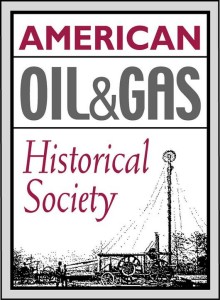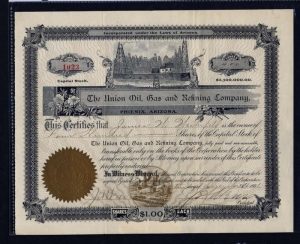Welcome to Old Oil Stocks – in progress “U” – but it is unlikely research here will lead to finding lost riches – see Not a Millionaire from Old Oil Stock. The American Oil & Gas Historical Society, which depends donations, does not have resources to provide free research of corporate histories.
However, AOGHS continues to look into forum queries as part of its energy education mission. Some investigations have revealed little-known stories like Buffalo Bill’s Shoshone Oil Company; many others have found questionable dealings during booms and epidemics of “black gold” fever like Arctic Explorer turns Oil Promoter.
 Visit the Stock Certificate Q & A Forum and view company updates regularly added to the A-to-Z listing at Is my Old Oil Stock worth Anything? AOGHS will continue to look into forum queries, including these “in progress.”
Visit the Stock Certificate Q & A Forum and view company updates regularly added to the A-to-Z listing at Is my Old Oil Stock worth Anything? AOGHS will continue to look into forum queries, including these “in progress.”
Uncle Sam Oil Company
Henry Harrison Tucker Jr. (1878-1959) is a colorful and litigious character whose petroleum ventures included both the Texas American Syndicate and Uncle Sam Oil Company. He left reams of court transcripts and contemporary media reports either supporting or condemning his operations.
In 1905 Tucker was celebrated by some as an oil patch David taking on the Goliath of John D. Rockefeller’s Standard Oil Company.
Tucker was excoriated by others, who described him as “a swindler and a fake more contemptible than any one of his breed for he mixed with his fraudulent compound vicious slander and libel in order to serve his mercenary purposes,” according to the July 22, 1922, Financial World. An earlier congressional report, “Leases for Oil and Gas Purposes, Osage National Council” by the U.S. House Committee on Indian Affairs (H.R. 27726), examined Uncle Sam Oil’s origins, operations and controversy in detail.
Union Oil & Gas Company/ Union Oil, Gas & Refining Company
 The beginning of the 20th century witnessed many new petroleum exploration companies. Although initially organized as an Arizona Territory corporation named the Union Oil & Gas Company with capitalization of $300,000, the company changed its name to Union Oil, Gas & Refining and increased its capitalization to $3.5 million by issuing stock.
The beginning of the 20th century witnessed many new petroleum exploration companies. Although initially organized as an Arizona Territory corporation named the Union Oil & Gas Company with capitalization of $300,000, the company changed its name to Union Oil, Gas & Refining and increased its capitalization to $3.5 million by issuing stock.
The company was under control of J.B, Atkins, president, when the periodical American Investor published a scathing analysis of its operations and described it as “organized primarily for the benefit of the promoters, and that this benefit is derived not only from the receipt of a large part of the capital stock for a small consideration, but also from the payment of excessive salaries.”
United Plains Oil Company
United Plains Oil Company lost its charter to do business on March 16, 1973, for failure to file required financial data and pay taxes. United Plains Oil Company is recorded as obsolete in Financial Securities Inc., 1982 Directory of Obsolete Securities.
United Southern Oil Company
In January 1920 the Petroleum Age reported that W.H. Henry, an agent of United Southern Oil Company of Wichita Falls, Texas, was arrested and arraigned in court for “misrepresentations in the sale of United Southern Oil Company stock.” During yet another North Texas drilling boom, Henry was charged with falsely claiming “the company had an 8,000 barrel producer…when he knew that the hole was dry” and that a second well was dry as well.
United Sulphur & Oil Company
United Sulphur & Oil Company formed in 1914 as an association of New Orleans businessmen looking to exploit the rich sulphur mining potential of Calcasieu Parish, Louisiana – and maybe find oil or natural gas as well. Possible oil production had been associated with the state’s sulfur mines near Lake Charles as early as 1886. The first Louisiana oil well discovered the Jennings oilfield a few miles to the east in 1901.
The oil producing sulfur regions of Calcasieu Parish would benefit when oil refining advanced thanks to Herman A. Frasch, who figured out a way to “sweeten” oil. Frasch patented a process for eliminating sulfur from “skunk-bearing oils.” His refining method would prove key for building the Standard Oil Company in Ohio, where John D. Rockefeller had accumulated a 40-million-barrel stockpile of cheap, sour “Lima oil.”
Standard Oil bought Frasch’s patent for a copper-oxide refining process to “sweeten” the oil from the Lima field. The desulfurized, odorless result multiplied in value, making Rockefeller a fortune. Paid in Standard Oil shares and soon wealthy himself, Frasch moved to Louisiana and patented a process for mining sulfur by injecting super heated water into a well. By 1911 he was known as the “Sulfur King.”
One journal notes that from 1905 to 1912, Calcasieu Parish “completely dominated the American sulphur producing industry.” United Sulphur & Oil Company purchased a promising 20 acres for $2,000. The company subdivided the land into 2,904 lots of 300 square feet for sale to investors at $30 a lot. With operating capital in hand, United Sulphur & Oil turned its attention the Toyah district of West Texas.
The El Paso Morning Times of November 28, 1915, reported, “Immense Deposits of Sulphur Found” and said that Fenton M. Dancy of United Sulphur & Oil Company would be developing three large sulphur deposits found in Reeves and Culberson Counties, Texas, near Toyah. Three months later plans were still underway, “with a view of beginning the shipments of sulphur within six months.”
Dancy reappears in July 1916 as president of the newly organized West Texas Sulphur Company, formed to exploit deposits near Pecos, Texas. Again in 1918, Dancy was named as president of Mariposa Mining Company, Terlingua. United Sulphur & Oil Company stock certificates with cancellation markings may have been surrendered in an exchange for stock in one of these companies.
United Texas Petroleum Company
United States Investor reported in June 1919 that United Texas Petroleum Company sold most of its 500,000 shares of stock at 50 cents a share and held leases on 10,000 acres of unproven territory in Maverick County, Texas. “Manipulation may send the stock up, but speculation of this sort is too risky…We should consider United Texas Petroleum Company as a gamble that should be left alone,” noted the publication.
True to the assessment, Texas Petroleum Company stock that sold on the curb market during 1920 never reached higher than its $1.50 opening and closed the year at 75 cents per share. By September 1922 value had fallen to one cent a share and United States Investor reported, “This stock is practically worthless.”
Uranium-Petroleum Company (Upetco)
On April 29, 1954, the newly formed Uranium-Petroleum Company of Salt Lake City, Utah, sought Securities and Exchange Commission approval for a 2 million share offering of common stock to the public. Prior to its initial public offering, company directors and executives bought and sold shares at between 20 cents and 23 cents each.
While awaiting approval, the stock was offered and promoted as far away as Brooklyn, N.Y., where newspaper advertisements promoted “a speculation in the fabulous future of Uranium-Petroleum Company…Upetco.” The stock was priced at 30 cents per share and the company purchased mining interests in Utah’s Copper Mountain area as well as in Fremont County, Wyoming, and Coconino County, Arizona. After Upetco had been selling its stock for two years, the Federal Register reported the company was offering a circular that was a “deceit upon purchasers” that “contains untrue statements of material facts and omits to state material facts necessary.”
Meanwhile, Upetco secured a 12 percent interest in a Fortune Petroleum Company venture in the Manderson field in Wyoming and completed a well that produced 745 barrels of oil a day in July 1957. By the next year the company had secured a $72,000 contract with the Atomic Energy Commission for uranium ore from its Arizona property. But internal disputes among the company’s directors resulted in litigation. Upetco’s fortunes began to fade.
Park Nelson Mining Company acquired Uranium-Petroleum Company in 1960 on the basis of one share of Park Nelson Mining for each 100 shares of Upetco. The next year, Park Nelson Mining reorganized as General Contracting Corporation. In December 1967 General Contracting’s trading ended on the Salt Lake Exchange, which had been organized in 1888 as the Salt Lake Stock & Mining Exchange in order to raise capital to develop the area’s metal mines.
U.S.A. Oil Company
After incorporating in Delaware on April 4, 1916, U.S.A. (or U-S-A) Oil Company began advertising to secure investors and funding to drill. Records indicate some drilling, but the company’s fortunes are unclear. A Google search with “1001 union bank” in quotes, returned (among other hits) a page identified as “The Ups-a Oil Company, 1001 Union Bank Building,” which connects one of several archived newspaper pages with advertisements by the U-S-A Oil Company from the Pittsburgh Gazette Times. Scripophily collectors of stock certificates offered U-S-A Oil Company stock certificates for about $50 in 2017.
The stories of exploration and production companies joining petroleum booms (and avoiding busts) can be found updated in Is my Old Oil Stock worth Anything? The American Oil & Gas Historical Society preserves U.S. petroleum history. Please support this AOGHS.ORG energy education website. For membership information, contact bawells@aoghs.org. © 2020 AOGHS

